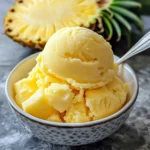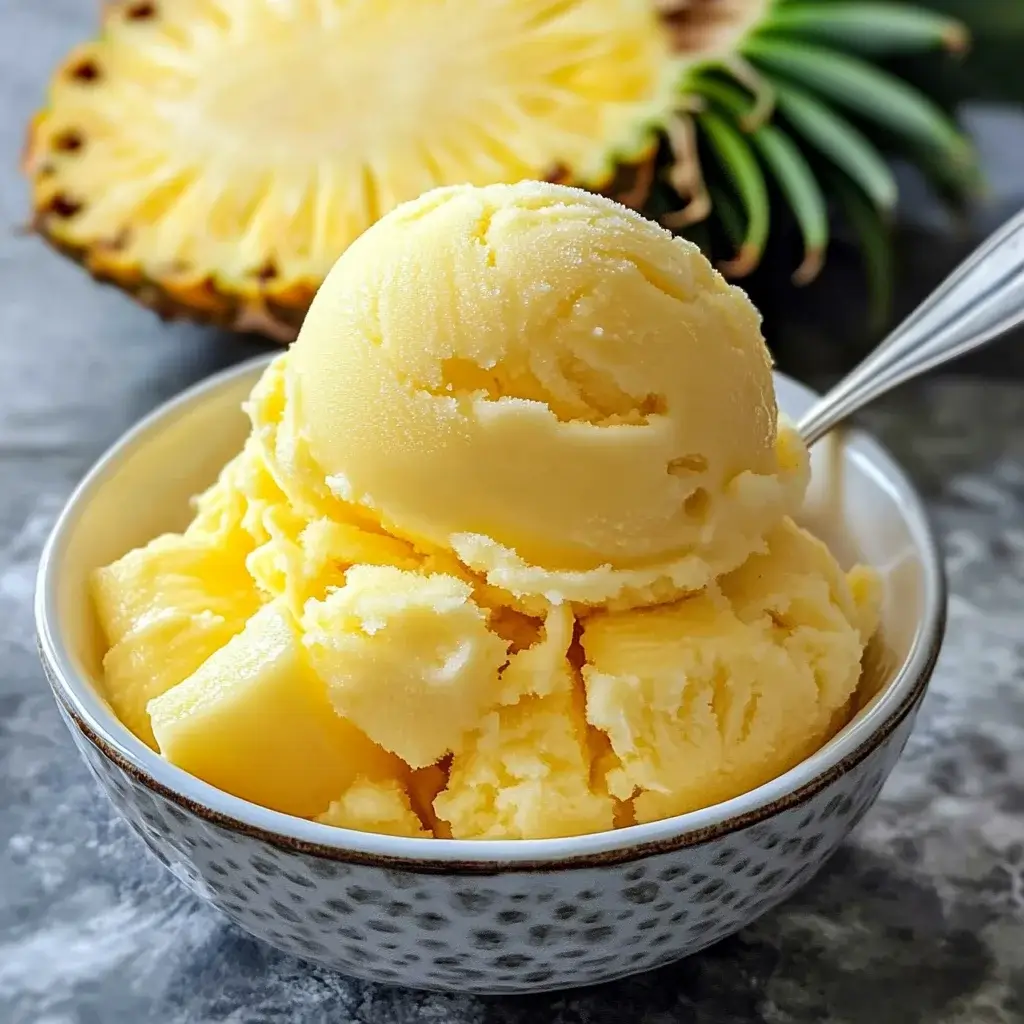The first time I whipped up this Instant Pineapple Sorbet, it felt like discovering a magic trick. It was a sweltering summer afternoon, the kids were restless, and the usual chorus of “I want ice cream!” had begun. Store-bought options often felt too sugary or artificial, and traditional sorbet-making seemed like too much effort for an immediate craving. Then, I remembered a bag of frozen pineapple chunks tucked away in the freezer. On a whim, I tossed them into the blender with a splash of coconut milk and a squeeze of lime. Within minutes – literally, minutes – we were staring at swirls of vibrant yellow, creamy-looking sorbet. The reaction was instantaneous joy. My husband, initially skeptical about anything “instant,” took one spoonful and his eyes widened. “Wow, that’s actually incredible,” he admitted. The kids devoured theirs, sticky smiles proving its success better than words could. It tasted intensely of pure, sweet pineapple with a tropical creaminess from the coconut and a bright zing from the lime. It wasn’t icy or gritty; it was smooth, refreshing, and felt surprisingly decadent for something so simple and healthy. Since that day, this Instant Pineapple Sorbet has become our go-to treat. It’s the perfect guilt-free dessert, a speedy snack, and honestly, just a delightful burst of sunshine in a bowl, no matter the season. Its simplicity is its genius, proving that sometimes the best things truly are the easiest.
Ingredients
- 4 cups Frozen Pineapple Chunks: (About 1 large pineapple, peeled, cored, and chopped, then frozen, or one 16-20 oz bag of store-bought frozen pineapple). The key is frozen solid fruit; this is what creates the instant sorbet texture without needing an ice cream maker. Using ripe, sweet pineapple ensures the best flavor.
- ¼ to ½ cup Liquid: (Options: Unsweetened Coconut Milk – canned, full-fat recommended for creaminess; Pineapple Juice – for extra pineapple punch; Cold Water – for a lighter sorbet; or even Coconut Water). Start with ¼ cup; add more only if needed to help the blender process the fruit. The liquid helps create a vortex and facilitates smooth blending.
- 1-2 tablespoons Sweetener (Optional): (Options: Maple Syrup, Agave Nectar, Honey – if not strictly vegan, or even a sugar-free alternative like erythritol). Adjust based on the natural sweetness of your pineapple and personal preference. Very ripe pineapple might not need any extra sweetness.
- 1 tablespoon Fresh Lime Juice (Optional but Recommended): Adds brightness and balances the sweetness of the pineapple, enhancing its tropical flavor profile. Lemon juice can be substituted in a pinch.
- Pinch of Salt (Optional): A tiny pinch helps to enhance all the other flavors, making the pineapple taste even fruitier and balancing the sweetness.
Instructions
- Prepare Your Equipment: Ensure your blender or food processor is ready. A high-speed blender (like a Vitamix or Blendtec) works best for achieving the smoothest texture quickly, but a powerful standard blender or a food processor can also work, potentially requiring a bit more liquid or patience.
- Combine Ingredients: Place the frozen pineapple chunks directly into the blender jar or food processor bowl. Add the smaller amount (¼ cup) of your chosen liquid (coconut milk, pineapple juice, or water). If using, add the optional sweetener, fresh lime juice, and pinch of salt. Starting with less liquid prevents the sorbet from becoming too thin or smoothie-like.
- Blend Carefully: Secure the lid on the blender or food processor. Start blending on a low speed, gradually increasing to high. If using a high-speed blender with a tamper, use it to push the frozen fruit down towards the blades. This helps immensely in getting things moving without adding excess liquid. If you don’t have a tamper, you may need to stop the blender periodically and scrape down the sides with a spatula, ensuring the lid is off or the machine is unplugged before putting the spatula inside!
- Achieve Smoothness: Continue blending until the mixture transforms from chunky frozen fruit into a smooth, thick, soft-serve consistency. This process should take anywhere from 1 to 5 minutes, depending on the power of your machine and how frozen the pineapple is. Be patient; it might look like it’s not working at first, but the friction and blades will eventually break down the fruit into a creamy sorbet. Avoid over-blending, which can generate heat and start melting the sorbet.
- Adjust Consistency (If Needed): If the mixture is too thick and the blender blades are struggling to move, add more liquid one tablespoon at a time, blending briefly after each addition, until it reaches the desired smooth, scoopable texture. Be cautious – adding too much liquid will turn it into a smoothie.
- Serve Immediately: For the true “instant” sorbet experience with the best soft-serve texture, scoop the sorbet directly from the blender or food processor into serving bowls or cones immediately.
- Optional Freezing for Firmer Sorbet: If you prefer a firmer, more traditional scoopable sorbet texture, transfer the blended mixture to a freezer-safe container (a loaf pan works well). Press a piece of plastic wrap or parchment paper directly onto the surface of the sorbet to prevent ice crystals from forming. Freeze for at least 1-2 hours, or until firm enough to scoop with an ice cream scoop. Note that freezing solid will make it harder, requiring some thawing time before serving (see tips).
Nutrition Facts
- Servings: Approximately 4 servings
- Calories per serving: Roughly 100-150 kcal (This is an estimate and can vary significantly based on the amount and type of liquid and optional sweetener used. Using only water and no sweetener will result in the lowest calorie count).
- Vitamin C: Pineapple is an excellent source of Vitamin C, a powerful antioxidant crucial for immune system function and skin health.
- Manganese: This tropical fruit provides a significant amount of manganese, an essential mineral involved in bone health, metabolism, and antioxidant defense.
- Dietary Fiber: Contains natural dietary fiber from the pineapple, which aids in digestion and promotes gut health.
- Naturally Low in Fat: This sorbet is virtually fat-free, especially if made with water or pineapple juice (using full-fat coconut milk will add some healthy fats).
- Natural Sugars: Primarily contains natural sugars from the fruit itself, offering a healthier sweetness compared to many processed desserts (especially if minimal or no added sweetener is used).
(Disclaimer: Nutritional information is an estimate only and calculated without optional ingredients unless specified. Actual values may vary based on specific ingredients, quantities used, and potential variations in fruit ripeness and composition.)
Preparation Time
- Total Time: 5 – 10 minutes
- Breakdown: This includes gathering the ingredients (assuming pineapple is already frozen) and the blending process. The primary factor influencing time is the power of your blender and how easily it processes the frozen fruit. If you need to stop and scrape down the sides frequently, it might take closer to the 10-minute mark. The beauty lies in its speed – it truly is an almost instant gratification dessert!
How to Serve
This Instant Pineapple Sorbet is delightful on its own, but here are several ways to serve it for extra flair or different occasions:
- Classic Scoop:
- Serve immediately in chilled bowls for that perfect soft-serve texture.
- Scoop into sugar cones or waffle cones for a classic ice-cream-shop feel.
- Garnishes Galore:
- Top with a sprig of fresh mint for a pop of color and cool aroma.
- Sprinkle with lime zest for an extra citrusy kick that complements the pineapple beautifully.
- Add toasted coconut flakes (unsweetened or sweetened) for textural contrast and enhanced tropical flavor.
- Garnish with a small, fresh pineapple wedge or a maraschino cherry for visual appeal.
- Drizzle with a touch of passion fruit pulp or mango puree.
- Tropical Parfait:
- Layer the pineapple sorbet in glasses with layers of granola, Greek yogurt (or coconut yogurt for vegan), and fresh berries (like raspberries or blueberries) for a stunning and satisfying breakfast or dessert parfait.
- Elegant Dessert Pairing:
- Serve a scoop alongside a slice of rich chocolate cake, pound cake, or coconut cake as a refreshing counterpoint.
- Pair with grilled pineapple slices for an intensified pineapple experience.
- Fun & Festive:
- Serve in hollowed-out pineapple halves or small coconut shells for a show-stopping tropical presentation at parties.
- Use fun-shaped ice cream molds if freezing for a firmer texture, perfect for kids.
- As a Float or Drink Base:
- Place a scoop in a glass and top with sparkling water, coconut water, or even a splash of rum for an adult pineapple float.
- Blend with a bit more liquid (like pineapple juice or coconut water) until pourable for a quick and healthy pineapple smoothie or mocktail base.
Additional Tips
- Start with Ripe Pineapple: If you’re freezing your own pineapple, ensure it’s perfectly ripe, sweet, and fragrant. An underripe pineapple will result in a tart sorbet that likely needs more sweetener, while an overripe one might have a fermented taste. Look for a pineapple with a sweet smell at the base, golden-yellow skin (depending on variety), and leaves that pull out relatively easily.
- Proper Freezing Technique: Cut the fresh pineapple into uniform, bite-sized chunks (around 1-inch). Spread them in a single layer on a baking sheet lined with parchment paper. Freeze until solid (at least 4-6 hours, or preferably overnight). Once frozen solid, transfer the chunks to a zip-top freezer bag or airtight container. Freezing them separately first prevents them from clumping into one giant block, making them much easier for your blender to handle.
- Blender Power Matters (But Isn’t Everything): While high-speed blenders excel, you can make this in a standard blender or food processor. For less powerful machines:
- Let the frozen pineapple sit at room temperature for 5-10 minutes to soften slightly (but not thaw!).
- Work in smaller batches if necessary.
- Be prepared to add a touch more liquid, slowly, to help it blend.
- Stop and scrape down the sides more often. A food processor often handles very thick mixtures well.
- Don’t Walk Away While Blending: Keep a close eye (and ear) on the blending process. You want it perfectly smooth, but over-blending can generate heat from the motor and blades, which will start melting your sorbet prematurely, making it runny instead of thick and frosty. Stop as soon as it reaches the desired consistency.
- Taste and Adjust Sweetness Before Serving: Pineapple sweetness varies greatly. Always taste the sorbet after blending but before serving. If it’s too tart for your liking, blend in a little more sweetener, one teaspoon at a time. If you added lime juice and it’s too zesty, a tiny bit more sweetener can balance it.
- Boost the Creaminess: For an extra rich and creamy sorbet, use full-fat canned coconut milk as your liquid. You could even add a tablespoon or two of coconut cream (the thick part from the top of a chilled can of full-fat coconut milk) during blending for ultimate decadence. A small piece of frozen banana (about ¼) can also add creaminess without significantly altering the pineapple flavor.
- Storing Leftovers (The Non-Instant Part): While best enjoyed instantly, leftovers can be stored. Transfer immediately to an airtight, freezer-safe container. To minimize ice crystals (the enemy of smooth sorbet), press plastic wrap or parchment paper directly against the surface of the sorbet before sealing the lid. Freeze. Note: It will freeze much harder than store-bought sorbet due to the lack of stabilizers and lower sugar/fat content. Let it sit at room temperature for 10-15 minutes before scooping to soften slightly. Re-blending briefly can sometimes restore some creaminess, but may also melt it too much.
- Experiment with Flavor Variations: Pineapple is a fantastic base for other flavors!
- Mango Tango: Replace 1 cup of frozen pineapple with 1 cup of frozen mango chunks.
- Pina Colada Vibes: Use coconut milk as the liquid and add a tablespoon of unsweetened shredded coconut during blending. A splash of rum extract (or actual rum for adults) enhances this.
- Ginger Zing: Add ½ teaspoon of freshly grated ginger or ¼ teaspoon of ground ginger during blending for a spicy kick.
- Herbal Notes: Blend in a few fresh mint leaves or basil leaves for a surprising and refreshing twist.
- Berry Blend: Add ½ cup of frozen raspberries or strawberries for a pineapple-berry sorbet.
Frequently Asked Questions (FAQ)
1. Can I use fresh pineapple instead of frozen?
No, not for this instant sorbet recipe. The entire magic of this recipe relies on using solidly frozen fruit. Blending frozen fruit chunks is what creates the thick, icy, sorbet-like texture immediately without needing an ice cream maker or extensive chilling time. Using fresh pineapple will result in a pineapple smoothie or juice, not sorbet. If you only have fresh pineapple, you’ll need to chop it and freeze it solid first (see Tip #2).
2. Can I make this recipe with canned pineapple?
It’s possible, but generally not recommended for the best results. Canned pineapple is often packed in syrup (making it overly sweet and requiring adjustments) and has a much softer, sometimes mushier texture even when frozen. You would need to drain it very thoroughly, then freeze the chunks solid. The final texture might be icier or less smooth compared to using fresh pineapple that you freeze yourself or good quality store-bought frozen chunks. Fresh or pre-frozen pineapple yields superior flavor and texture.
3. My sorbet froze rock solid! How do I scoop it?
This is common for homemade sorbets made without stabilizers or high amounts of sugar/fat. Simply take the container out of the freezer and let it sit on the counter at room temperature for about 10-15 minutes (the exact time depends on room temperature and how much sorbet is in the container). It should soften just enough around the edges and top to allow you to scoop it. Running your ice cream scoop under hot water can also help. Avoid microwaving it, as this tends to melt it unevenly.
4. What is the best type of blender or appliance to use?
A high-speed blender (like Vitamix, Blendtec, or similar powerful models) is ideal because its strong motor and blade design can pulverize frozen fruit quickly into a smooth consistency, often with minimal added liquid, thanks to the tamper. However, a good-quality standard blender or a sturdy food processor can also work well. With these, you might need to let the fruit soften slightly first, add a bit more liquid incrementally, stop to scrape down the sides more often, or blend in smaller batches. A food processor is often quite capable of handling thick, frozen mixtures.
5. How long will this Instant Pineapple Sorbet last in the freezer?
While it’s best enjoyed immediately for the optimal soft-serve texture, you can freeze leftovers in an airtight container with plastic wrap pressed onto the surface. For the best quality and minimal ice crystal formation, try to consume it within 1-2 weeks. It will remain safe to eat for longer (1-2 months), but the texture will likely degrade over time, becoming icier and harder.
6. Is this pineapple sorbet recipe vegan and dairy-free?
Yes, absolutely! As long as you use water, pineapple juice, coconut milk, or coconut water as your liquid, and choose a vegan sweetener like maple syrup or agave nectar (or omit sweetener altogether), this recipe is entirely plant-based, vegan, and dairy-free. Avoid honey if making it strictly vegan.
7. Do I have to add sweetener? Can I make it sugar-free?
No, you don’t have to add any sweetener. Whether you need it depends entirely on the natural sweetness of your pineapple and your personal taste preferences. A perfectly ripe, sweet pineapple often yields a delicious sorbet with no added sugar. Taste the mixture after blending; if it tastes great to you, skip the sweetener! This makes it an even healthier, naturally sweetened treat. If using a sugar substitute, add according to your preference.
8. Can I add other frozen fruits to this recipe?
Definitely! Pineapple pairs wonderfully with many other fruits. You can easily substitute part of the frozen pineapple with other frozen fruits like mango, strawberries, raspberries, peaches, or even a small amount of banana (which adds extra creaminess). Just keep the total amount of frozen fruit roughly the same (around 4 cups) and adjust liquid/sweetener as needed based on the fruits used. Experimenting is part of the fun!

Instant Pineapple Sorbet
Ingredients
- 4 cups Frozen Pineapple Chunks: (About 1 large pineapple, peeled, cored, and chopped, then frozen, or one 16–20 oz bag of store-bought frozen pineapple). The key is frozen solid fruit; this is what creates the instant sorbet texture without needing an ice cream maker. Using ripe, sweet pineapple ensures the best flavor.
- ¼ to ½ cup Liquid: (Options: Unsweetened Coconut Milk – canned, full-fat recommended for creaminess; Pineapple Juice – for extra pineapple punch; Cold Water – for a lighter sorbet; or even Coconut Water). Start with ¼ cup; add more only if needed to help the blender process the fruit. The liquid helps create a vortex and facilitates smooth blending.
- 1–2 tablespoons Sweetener (Optional): (Options: Maple Syrup, Agave Nectar, Honey – if not strictly vegan, or even a sugar-free alternative like erythritol). Adjust based on the natural sweetness of your pineapple and personal preference. Very ripe pineapple might not need any extra sweetness.
- 1 tablespoon Fresh Lime Juice (Optional but Recommended): Adds brightness and balances the sweetness of the pineapple, enhancing its tropical flavor profile. Lemon juice can be substituted in a pinch.
- Pinch of Salt (Optional): A tiny pinch helps to enhance all the other flavors, making the pineapple taste even fruitier and balancing the sweetness.
Instructions
- Prepare Your Equipment: Ensure your blender or food processor is ready. A high-speed blender (like a Vitamix or Blendtec) works best for achieving the smoothest texture quickly, but a powerful standard blender or a food processor can also work, potentially requiring a bit more liquid or patience.
- Combine Ingredients: Place the frozen pineapple chunks directly into the blender jar or food processor bowl. Add the smaller amount (¼ cup) of your chosen liquid (coconut milk, pineapple juice, or water). If using, add the optional sweetener, fresh lime juice, and pinch of salt. Starting with less liquid prevents the sorbet from becoming too thin or smoothie-like.
- Blend Carefully: Secure the lid on the blender or food processor. Start blending on a low speed, gradually increasing to high. If using a high-speed blender with a tamper, use it to push the frozen fruit down towards the blades. This helps immensely in getting things moving without adding excess liquid. If you don’t have a tamper, you may need to stop the blender periodically and scrape down the sides with a spatula, ensuring the lid is off or the machine is unplugged before putting the spatula inside!
- Achieve Smoothness: Continue blending until the mixture transforms from chunky frozen fruit into a smooth, thick, soft-serve consistency. This process should take anywhere from 1 to 5 minutes, depending on the power of your machine and how frozen the pineapple is. Be patient; it might look like it’s not working at first, but the friction and blades will eventually break down the fruit into a creamy sorbet. Avoid over-blending, which can generate heat and start melting the sorbet.
- Adjust Consistency (If Needed): If the mixture is too thick and the blender blades are struggling to move, add more liquid one tablespoon at a time, blending briefly after each addition, until it reaches the desired smooth, scoopable texture. Be cautious – adding too much liquid will turn it into a smoothie.
- Serve Immediately: For the true “instant” sorbet experience with the best soft-serve texture, scoop the sorbet directly from the blender or food processor into serving bowls or cones immediately.
- Optional Freezing for Firmer Sorbet: If you prefer a firmer, more traditional scoopable sorbet texture, transfer the blended mixture to a freezer-safe container (a loaf pan works well). Press a piece of plastic wrap or parchment paper directly onto the surface of the sorbet to prevent ice crystals from forming. Freeze for at least 1-2 hours, or until firm enough to scoop with an ice cream scoop. Note that freezing solid will make it harder, requiring some thawing time before serving (see tips).
Nutrition
- Serving Size: one normal portion
- Calories: 150






